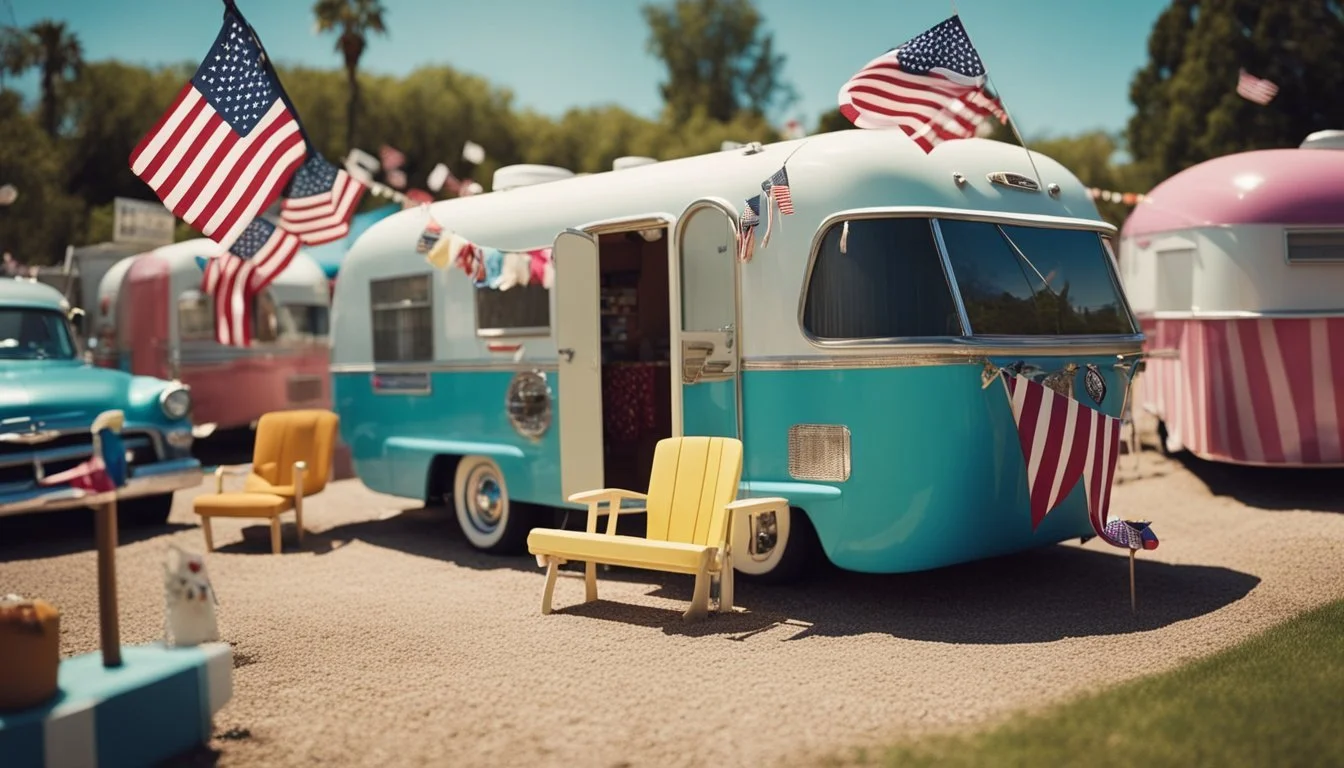The Cultural Impact of The Great American Trailer Park Musical
An Analytical Perspective
Since its debut off-Broadway in 2005, "The Great American Trailer Park Musical" has carved a niche for itself in the landscape of American theater, offering a satirical yet heartfelt glimpse into life at a fictional trailer park in Florida. Its impact stems from a humorous exploration of social stereotypes and the often-overlooked stories of those living in trailer parks, stirring both laughter and sympathy. The musical showcases the tangled lives of its colorful characters amidst the backdrop of Armadillo Acres, blending humor with poignant commentary.
The musical's characters, including Pippi the stripper and Jeannie struggling with agoraphobia, add depth and color to its narrative. These engaging personas invite audiences to look beyond societal preconceptions, fostering discussions around themes of love, loyalty, and community resilience. With catchy tunes crafted by David Nehls and a sharp script by Betsy Kelso, it stands as a reminder that compelling stories can emerge from the most unexpected places.
"The Great American Trailer Park Musical" has found success beyond its original run, with regional theaters across the U.S. embracing its unique charm. Its resonance with audiences suggests a broader cultural impact, offering commentary on the American Dream and its accessibility. By balancing comedy with sincere portrayals, the musical continues to entertain while provoking meaningful reflection.
Production History
"The Great American Trailer Park Musical" has had a diverse journey from its origins to various productions across the United States. Its debut brought humor and heart to audiences, establishing itself in the theatrical world with several notable productions.
Origins and Off-Broadway Run
Originally conceived at the New York Musical Theatre Festival, the musical made its mark with a distinctive comedic approach. It premiered Off-Broadway at Dodger Stages on September 27, 2005. Jean Doumanian, Jeffrey Richards, and Rick Steiner produced the show. Betsy Kelso directed the Off-Broadway premiere, while David Nehls composed music and lyrics that resonated with audiences.
The show depicted the eccentric lives of trailer park residents in Florida. Its unique blend of humor and musical storytelling quickly gained attention, leading to a successful initial run.
National Tour and Regional Productions
Following its Off-Broadway success, the musical launched a national tour that brought it to new audiences. Various theaters, including the Hippodrome in Gainesville, Florida, and Hart House Theatre, hosted productions. These performances maintained the whimsical charm of the original, drawing diverse audiences.
Stages Repertory Theatre and Miners Alley Playhouse also staged their versions, each adding unique elements to the production. These regional adaptations showcased the musical's broad appeal and continued influence, cementing its place in the landscape of American theater.
Synopsis and Themes
"The Great American Trailer Park Musical" offers a vibrant portrayal of life in a Florida trailer park. It combines elements of humor and drama, focusing on relational dynamics, individual struggles, and community spirit.
Plot Overview
Set in the fictional Armadillo Acres, this musical centers on the lives of the residents, including Jeannie, an agoraphobic housewife, and her husband Norbert. Their troubled marriage faces a new threat when Pippi, an exotic dancer, moves into the park, stirring up romance and chaos.
Amid these developments, Pippi's abusive ex-boyfriend adds tension, culminating in dramatic confrontations and an attempted abduction. The storyline is lightened by a Greek-chorus-like trio of women who guide the narrative, offering humor and insight.
Thematic Elements
At its core, the musical explores themes like love, infidelity, and personal growth. It examines the effects of a loveless marriage and the ways individuals grapple with internal and external conflicts.
The community aspect of trailer park life highlights contrasting personal struggles, bringing out both the absurdity and the warmth of these connections. Agoraphobia, dreams of freedom, and the battle between comfort zones and change serve as powerful backdrops for character development.
Friendship and resilience in the face of adversity become crucial, as the residents navigate their tangled lives, revealing deeper layers of support and understanding.
Characters and Performers
The Great American Trailer Park Musical showcases a vibrant cast of characters and talented performers who bring the story to life. The musical's narrative focuses on intriguing personalities and the skilled actors who portray them.
Central Characters
Jeannie Garstecki, an agoraphobic housewife, is a central figure whose life is disrupted by the arrival of Pippi, a stripper on the run. Norbert, Jeannie's tollbooth collector husband, provides a comedic yet heartfelt dimension as he battles with his feelings for both women. Meanwhile, Pippi's presence causes turmoil in Armadillo Acres, the trailer park where she takes refuge.
Supporting the drama, Betty is an outspoken manager of the trailer park who adds humor and wit to the story. Lin (short for Linoleum) is a neurotic neighbor dealing with her own struggles, and Pickles, another resident, brings quirky charm with her naïve outlook. These characters collectively create a dynamic ensemble that resonates with audiences through humor and authenticity.
Notable Cast Members
Betsy Kelso, who penned the book for this musical, plays a vital role behind the scenes alongside composer and lyricist David Nehls. Their work has been performed by various talented actors, contributing to its success on stage.
Susan Koozin and Carolyn Johnson are among performers praised for their roles, demonstrating versatility and engaging audience members night after night. Brooke Wilson has also received acclaim for her portrayal, adding depth to the production with her compelling performance. Through these accomplished actors, the show's vibrant characters come alive, offering both comedic and dramatic storytelling elements.
Creative Team
Betsy Kelso serves as the book writer for The Great American Trailer Park Musical. Her work on this musical includes crafting a story centered around a humorous yet poignant look at life in a trailer park.
David Nehls is responsible for the music and lyrics. His compositions add a vibrant energy, blending country, rock, and pop influences.
The duo of Kelso and Nehls has collaboratively created a musical experience that combines wit and charm. Each member of this creative team contributes uniquely to the development and success of the show, resulting in a piece that resonates with audiences.
Cultural Significance
"The Great American Trailer Park Musical" brings to light the vibrant tapestry of trailer park life in places like Armadillo Acres in Starke, Florida. It explores diverse themes and the community dynamics of trailer park residents, portrayed through its engaging narrative and music. This musical has garnered attention from both audiences and critics for its portrayal and humor.
Representation of Trailer Park Life
The musical presents a lively depiction of daily life in Armadillo Acres Trailer Park. It captures the essence of the community’s challenges and joys, focusing on its residents' unique stories. The musical doesn't shy away from stereotypes associated with trailer park living, like financial struggles and vibrant personalities, but treats them with humor and empathy.
Trailer park women play a pivotal role in the production, offering a fresh narrative that highlights resilience and camaraderie. They provide insight into their world, showcasing strength in adversity and fostering a sense of belonging. The musical's characters navigate complex relationships, adding depth and authenticity, which resonates with audiences familiar with or curious about this lifestyle.
Musical's Impact on Audience and Critics
Critics and audiences have responded positively to the whimsical yet heartfelt portrayal of trailer park life. The narrative blends humor with sensitive themes, offering a comedic yet genuine reflection of the human experience. It challenges conventional perspectives, encouraging viewers to appreciate the complexity of communities often subject to misjudgment.
The musical's ability to entertain while provoking thought and fostering understanding has cemented its place in the theatrical landscape. Its reception underscores the power of storytelling in shedding light on underrepresented social groups, making it a significant cultural milestone. Through the lively performances and engaging score, it continues to captivate and broaden audience perspectives.
Musical Style and Choreography
"The Great American Trailer Park Musical" features a distinctive blend of musical styles and lively choreography that capture the essence of its colorful characters and setting. with musical influences ranging from country to disco, alongside vibrant choreography, the musical paints a vivid portrait of life in its unique environment.
Musical Influences
The score of "The Great American Trailer Park Musical" taps into diverse genres, creating a compelling soundtrack that enhances the storyline. The incorporation of country music roots the narrative in its Southern setting. Furthermore, hints of disco inject energy and nostalgia, reflecting the characters’ aspirations and dreams. Other influences include rock and blues, collectively offering a dynamic auditory experience that mirrors the chaotic yet heartfelt life in a trailer park.
This variety ensures that each character’s voice is distinct and memorable. High school sweethearts Jeannie and Norbert’s melodies often evoke a nostalgic feel, which highlights their enduring relationship amidst turmoil, adding depth to their story.
Choreographic Highlights
Choreographer Sergio Trujillo brings high-energy routines to the stage, utilizing styles that complement the musical's humor and heart. The choreography is often fast-paced and lively, capturing the emotional highs and lows of the characters.
There are moments akin to the theatrical energy found in productions like "Hair," where group numbers become pivotal storytelling devices. The use of elements reminiscent of spectacular shows like the Ice Capades provides a whimsical touch. These choreographic choices contribute to an engaging performance, making the viewers feel involved in the onstage antics. Through synchronized group dances and expressive solos, the cast embodies the spirit of the trailer park, making each performance a visual and emotional feast.
Set and Costume Design
The visual aspects of "The Great American Trailer Park Musical" effectively reflect its themes and setting. The set incorporates detailed elements to create the trailer park environment, while costumes enhance the character portrayal.
Scenic Elements
The set design of "The Great American Trailer Park Musical" plays a crucial role in immersing the audience. W. Kris Clayton's designs showcase a realistic trailer park setting with elements like colorful trailers and vintage lawn ornaments. Linoleum flooring is often featured, adding an authentic touch to the onstage homes. The use of props, such as tacky decorations and weather-worn furniture, aids in painting a vivid picture of the characters' lives.
Attention to detail is vital, as the scenic elements not only illustrate the physical space but also highlight the culture and lifestyle of the residents. The intentional placement of objects communicates subtle nuances about the characters, adding depth to their stories.
Costume Inspiration
Costumes in "The Great American Trailer Park Musical" are crafted to underscore the personalities and backgrounds of each character. Designed by Markas, the outfits often feature a mix of bold patterns, denim, and kitschy prints that echo the Southern trailer park setting. For instance, the character of the exotic dancer might don flashy outfits, drawing from retro fashion trends and emphasizing her flamboyant personality.
Costumes also incorporate elements like flannel shirts, adding a layer of authenticity and helping to convey the theatrical and comedic aspects of the show. These designs serve not just as clothing but as visual narratives, contributing significantly to the storytelling and enhancing the audience's understanding of the characters' lives.
Reception and Legacy
"The Great American Trailer Park Musical" has left a unique mark on the theater scene, drawing comparisons to other cult favorites like The Rocky Horror Show. Its comedic narrative and lively score have continued to entertain audiences since its Off-Broadway premiere. The subsequent tours and local productions have helped it maintain a strong presence within the community theater circuit.
Critical Response
Upon its Off-Broadway debut, this musical garnered attention for its humorous and satirical portrayal of life in a Florida trailer park. Critics praised its lively score by David Nehls and witty book by Betsy Kelso.
The production received favorable reviews for balancing humor with relatable themes. Although some critics noted its niche appeal, it quickly developed a dedicated fanbase, akin to The Rocky Horror Show. Box office success followed as word-of-mouth increased ticket sales.
Longevity and Influence
Since opening in 2005, the show has enjoyed various regional productions, maintaining its popularity in community theaters across the U.S. and even internationally. This continued interest contributed to a sequel, showcasing its lasting impact on audiences.
The show's blend of humor and catchy songs resonates widely, influencing the modern musical landscape. Productions in locations such as Denver highlight its ongoing appeal. The Great American Trailer Park Musical remains a fixture in theatrical repertoires, celebrated for its vibrant characters and cultural commentary.
Marketing and Audience Engagement
"The Great American Trailer Park Musical" cleverly uses bold characters and humor to engage its audience. With themes like hysterical pregnancy, a stripper, and an agoraphobic wife, the musical captivates viewers by breaking the fourth wall. This technique creates an interactive experience, encouraging spectators to laugh and become part of the story.
Through a lively Greek chorus, the musical draws in audiences, narrating events in a whimsical yet clear manner. This storytelling method ensures that even complex or unfamiliar concepts are accessible, bridging any gaps between viewers' knowledge and the unfolding drama.
Marketing efforts highlight the musical's unique elements, including anniversaries and pop culture references such as Dr. Phil, attracting a diverse audience. The inclusion of relatable and occasionally outrageous situations helps to maintain interest in its storyline while ensuring the musical's broad appeal.
By portraying the ability to live in peace despite chaotic circumstances, the production resonates with audiences seeking humor amid life's difficulties. The quirky yet relatable character dynamics further engage viewers, inviting them on a journey that echoes their own experiences.
The show's creative promotion emphasizes its status as a celebration of life's eccentricities. This strategy effectively draws audiences eager for light-hearted entertainment. As such, "The Great American Trailer Park Musical" finds success in both live performances and regional productions, ensuring its place in contemporary theater.









